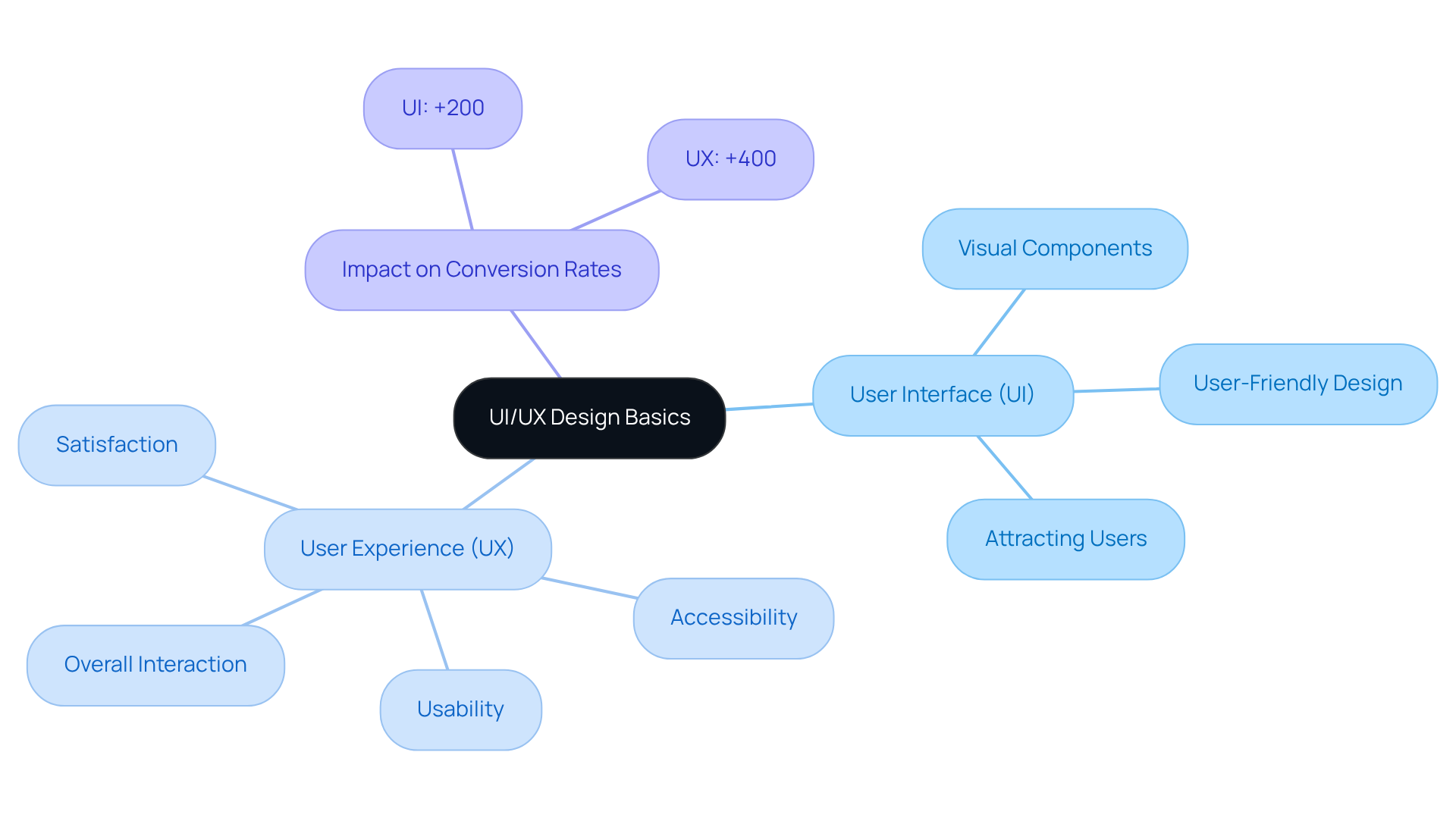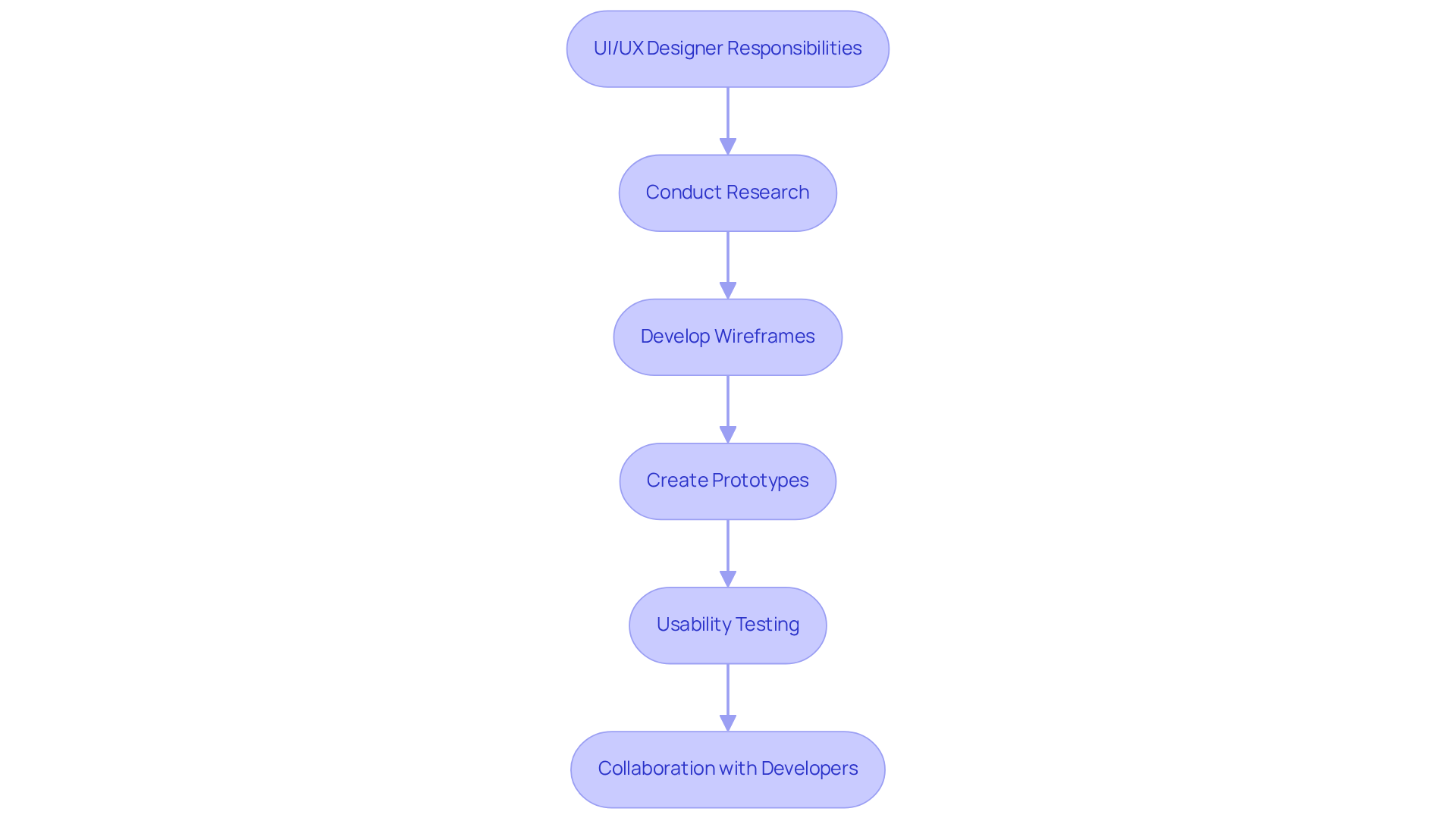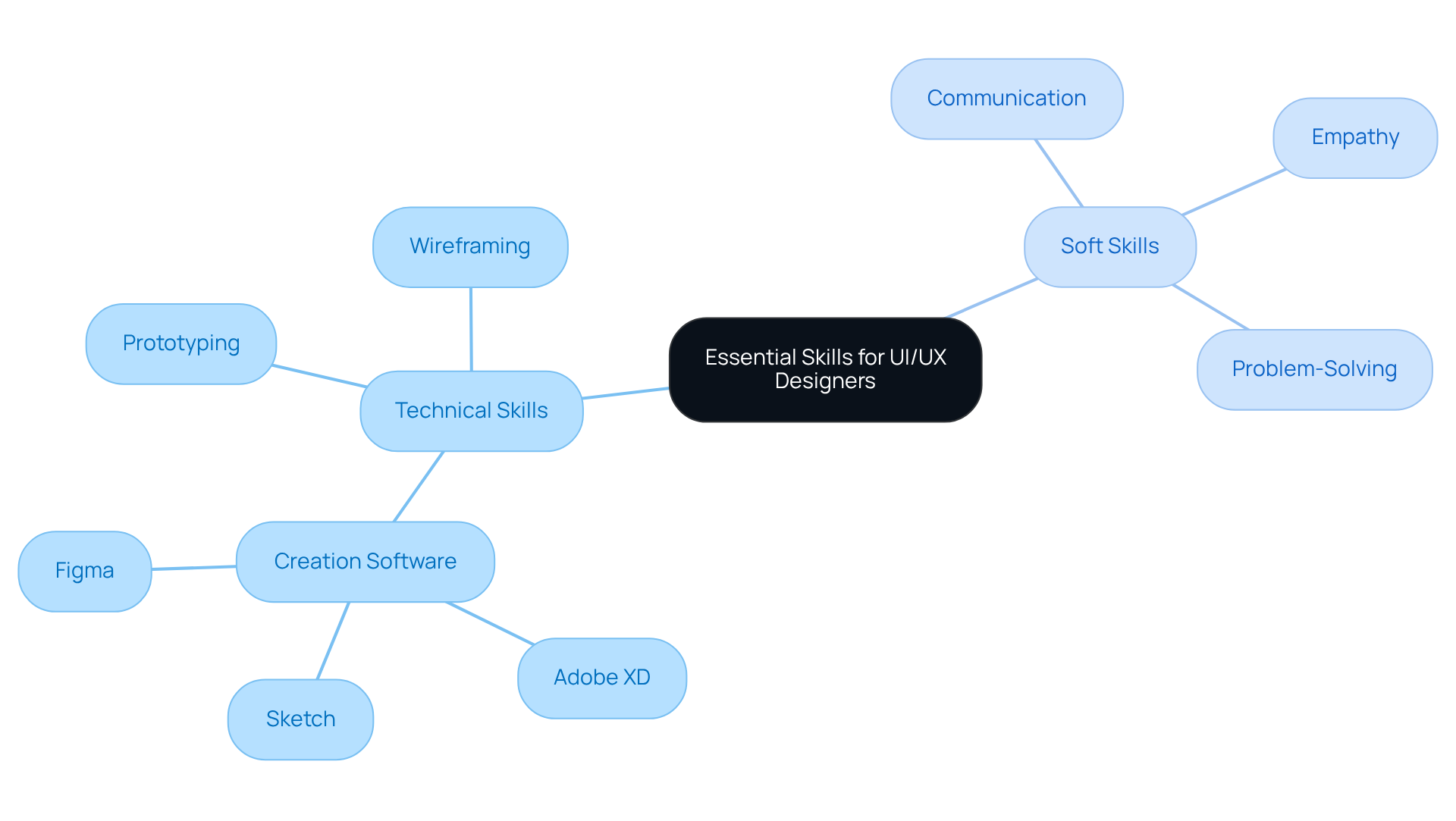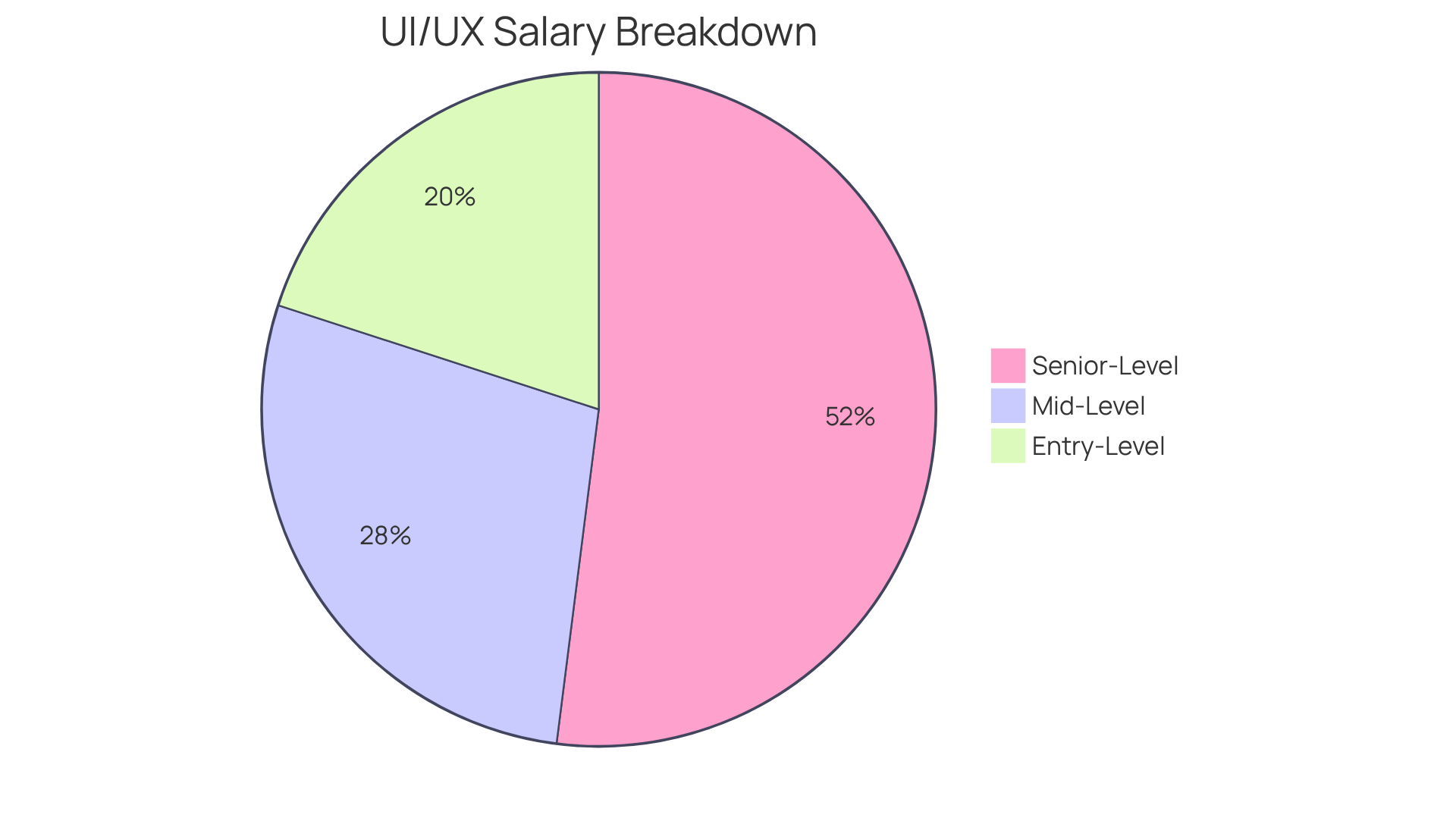Overview
This article highlights the crucial roles, skills, and market insights associated with UI/UX designer jobs, underscoring their significance in crafting user-friendly and visually appealing digital products. It begins by acknowledging the challenge many startups face: creating engaging digital experiences that truly resonate with users. Without skilled designers, products can fall short of user expectations, leading to frustration and lost opportunities.
By detailing the responsibilities of UI/UX designers, the essential technical and soft skills they must possess, and the competitive salary landscape, we illustrate how these factors contribute to the increasing demand for professionals in this field. This growing need reflects not only the complexity of design but also the profound impact these roles have on the success of digital products.
We invite you to consider how investing in talented UI/UX designers can transform your digital offerings and enhance user satisfaction, fostering a more connected and successful startup journey.
Introduction
In today's ever-changing digital landscape, aspiring UI/UX designers face a significant challenge: how to stand out in a competitive job market. As businesses increasingly recognize the importance of user-centered design, the pressure to develop the right skills and insights can feel overwhelming. This realization can provoke anxiety for those looking to build a successful career in this field. However, it’s essential to remember that you are not alone in this journey. Many have navigated these waters before you and found their way to success.
This article aims to shed light on the essential roles, skills, and market trends that are shaping the future of UI/UX design. By understanding these elements, you can equip yourself with the tools needed to thrive. We’ll delve into practical guidance and share personal stories from those who have faced similar challenges, offering you a sense of community and support as you embark on or advance your career in this dynamic arena. Together, we can explore the path to becoming a skilled professional in UI/UX design, nurturing your growth and confidence along the way.
Define UI/UX Design: Understanding the Basics
Creating an effective UI (User Interface) can be a daunting challenge for many tech startup founders. You may find yourself overwhelmed by the need to ensure that your product's visual components—buttons, icons, and layout—are not only appealing but also . This struggle is common, as a well-designed interface is crucial for attracting and retaining users.
On the other hand, UX (User Experience) development encompasses the overall interaction individuals have with your product, focusing on usability, accessibility, and satisfaction. It's essential to recognize that these two elements work hand in hand. Together, UI and UX collaborate to create products that are both visually appealing and functional, enhancing engagement and retention.
This synergy is vital; research shows that a well-designed UI can boost conversion rates by up to 200%, while a superior UX can double that impact to an impressive 400%.
At RNO1, we understand these challenges and are dedicated to a creation-focused approach. Our strategies for UI and UX are grounded in effective solutions tailored to your needs. By grasping these definitions, you set the stage for exploring the roles and skills that will empower your journey later in this article. Remember, you are not alone in this process; we are here to support you every step of the way.

Explore UI/UX Designer Roles: Key Responsibilities and Tasks
In the ever-evolving world of digital platforms, professionals in interface and experience design face the significant challenge of crafting meaningful interactions. Their responsibilities often shift to meet the unique needs of each project and organization. These dedicated individuals conduct research to uncover user needs, develop wireframes and prototypes to visualize ideas, and collaborate closely with developers to ensure that the end product aligns with specifications. For instance, a user interface and experience specialist might focus on a mobile application, striving to create an intuitive navigation system that also reflects the brand's identity.
As we look towards 2025, the responsibilities of interface and experience creators will increasingly include usability testing to gather feedback and refine their designs. This process is vital for enhancing audience satisfaction. Research shows that a staggering 94% of first impressions of a brand's website are influenced by its layout, underscoring the critical role of effective UI/UX practices in fostering trust and engagement. Moreover, statistics reveal that companies lose an average of 35% of sales due to poor user experience, highlighting the dire financial implications of neglecting design. Conversely, businesses that prioritize customer experience can witness conversion rates soar by as much as 400%.
Wireframing and prototyping are integral to the design process, allowing creators to iterate on concepts swiftly and effectively. Talented designers often turn to tools like Figma or Sketch to craft interactive prototypes that facilitate testing and feedback collection. A notable example is JobNimbus, which successfully improved its app ratings from 2.5 to 4.8 by actively listening to user feedback and refining its UX design. This involved simplifying navigation and enhancing visual appeal. Such an iterative approach not only boosts user engagement but also drives higher conversion rates, as evidenced by the fact that every dollar spent on UX can yield a remarkable return of $100.
Ultimately, the role of UI/UX designer jobs is both dynamic and essential, especially in tech startups. Understanding is crucial for creating products that resonate with target audiences. By embracing a compassionate approach to design, these professionals not only enhance user experiences but also contribute to the overall success of their organizations.

Identify Essential Skills for UI/UX Designers: Technical and Soft Skills
UI/UX professionals often face the challenge of balancing technical and interpersonal skills to truly thrive in their roles. The technical landscape is demanding, requiring proficiency in creation software like Adobe XD, Sketch, and Figma, along with a solid grasp of prototyping and wireframing techniques. These skills empower creators to craft effective visual representations of their ideas and streamline the creation process. With the at a CAGR of 16.2% from 2021 to 2028, the demand for UI/UX designer jobs is more pressing than ever in this evolving field.
On the softer side, effective communication, empathy, and problem-solving abilities are essential. Consider how robust communication skills play a vital role when presenting concepts to stakeholders; they help articulate the reasoning behind design choices clearly. Empathy, on the other hand, allows creators to truly understand and respond to the needs of individuals, resulting in audience-focused solutions that resonate deeply. As one creative leader insightfully remarked, "Curiosity helps them get to the root of any problem," highlighting the mindset necessary for success in this dynamic field.
Success stories from the industry frequently illustrate how creators who excel in these interpersonal skills foster collaboration within cross-functional teams, including Product Managers and Developers. This collaboration ultimately enhances the overall user experience. By merging technical expertise with interpersonal abilities, professionals in user interface and experience can create impactful solutions that not only meet user expectations but also drive business success. Together, we can nurture a community where both technical and soft skills are valued, paving the way for a brighter future in UX.

Analyze the Job Market: Opportunities and Salary Insights for UI/UX Designers
The employment landscape for user interface and experience professionals is swiftly changing, and this shift can feel overwhelming. As awareness grows regarding the importance of user-focused design across various sectors, many may find themselves grappling with the need to adapt.
By 2025, entry-level UI/UX professionals can expect salaries averaging around $62,500, while mid-level professionals typically earn about $92,500. For those who have honed their skills over the years, senior professionals can command impressive salaries exceeding $135,000 annually.
In such a competitive environment, it’s essential for creators to consistently refresh their skills to remain relevant. This can be a source of anxiety, as proficiency in AI tools and data-driven design methodologies is increasingly sought after. Companies are eager to leverage innovative technologies to enhance user experiences, which can leave many feeling the pressure to keep up.
The demand for UI/UX designer jobs is particularly pronounced in tech startups, where salaries range from $55,000 to $100,000, often supplemented by equity compensation. This dynamic environment highlights the in the field.
Remember, you’re not alone in this journey; embracing change and seeking out opportunities for growth can lead to fulfilling career advancements.

Conclusion
The intricate world of UI/UX design presents a crucial challenge for many in the tech industry, as it significantly shapes user interactions and experiences with digital products. The nuances of both User Interface and User Experience are not just details; they are essential elements in crafting designs that are engaging, functional, and visually appealing—elements that truly meet user needs. As technology evolves at a rapid pace, the demand for skilled UI/UX designers continues to grow, underscoring the importance of these roles in the success of both tech startups and established companies.
Throughout this article, we explored key insights into the responsibilities of UI/UX designers, highlighting vital tasks such as:
- Conducting user research
- Creating wireframes
- Collaborating with development teams
We also discussed the essential skills required for these roles, which encompass technical proficiencies in design software as well as the soft skills necessary for effective communication and empathy. Additionally, valuable market insights revealed promising salary trends and the increasing need for adaptability as the industry shifts toward data-driven design methodologies and innovative technologies.
In light of these findings, it becomes evident that investing in UI/UX design is not merely a trend but a necessity for businesses striving to thrive in a competitive landscape. Aspiring designers are encouraged to focus on enhancing both their technical and interpersonal skills while staying informed about market developments to seize new opportunities. Embracing the dynamic nature of this field will not only foster personal growth but also contribute significantly to the overall success of their organizations. The future of UI/UX design is indeed bright, and those who are willing to adapt and innovate will undoubtedly lead the way.
Frequently Asked Questions
What is UI design?
UI (User Interface) design refers to the creation of the visual components of a product, such as buttons, icons, and layout, ensuring they are appealing and user-friendly.
What is UX design?
UX (User Experience) design encompasses the overall interaction individuals have with a product, focusing on usability, accessibility, and user satisfaction.
How do UI and UX work together?
UI and UX collaborate to create products that are visually appealing and functional, enhancing user engagement and retention.
Why is a well-designed UI important?
A well-designed UI is crucial for attracting and retaining users, as it significantly impacts the overall user experience.
What impact can a well-designed UI have on conversion rates?
Research shows that a well-designed UI can boost conversion rates by up to 200%.
What impact can superior UX have on conversion rates?
A superior UX can double the impact of a well-designed UI, potentially increasing conversion rates to an impressive 400%.
What approach does RNO1 take towards UI and UX design?
RNO1 adopts a creation-focused approach, providing effective solutions tailored to the specific needs of clients in their UI and UX design efforts.




